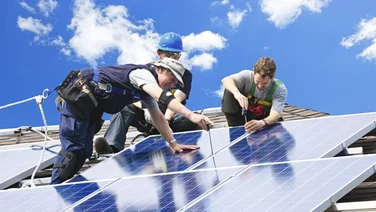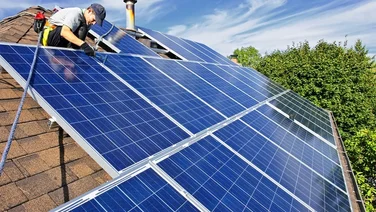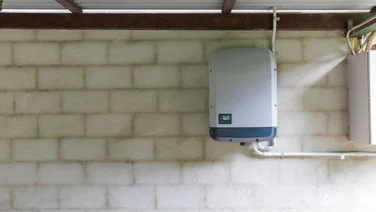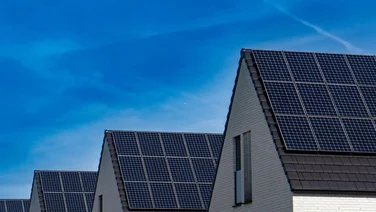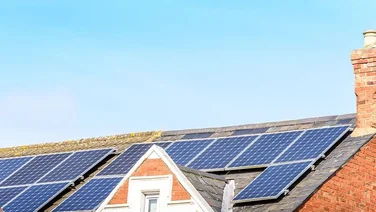- What are ground-mounted solar panels?
- How much do ground-mounted solar panels cost?
- How much space do ground-mounted solar panels need?
- Ground-mounted solar panels vs roof-mounted solar panels
- Do I need planning permission for ground-mounted solar panels?
- Aesthetic implications of ground-mounted solar panels
- Summary
- Ground-mounted panels can produce 25% to 35% more electricity compared to roof-mounted panels
- They can be angled and directed very easily to achieve maximum efficiency
- Systems larger than nine square metres require planning permission

Ground-mounted solar panels are more efficient than roof-mounted solar panels, as achieving the best angle and direction is easier when no roof is in the way. This setup also enables the installation of bifacial solar panels, which can turn more sunlight into power.
They are also cooler than those installed on roofs, meaning they are more efficient for longer. But, they are also more prone to obstacles, like buildings or trees, blocking their sun exposure.
Ground-mounted panels are just one example of low-carbon technology (LCT) that helps reduce emissions and increase energy efficiency, such as a solar panel or heat pump. According to our latest National Home Energy Survey (NHES), 93% of people asked in the UK are aware of at least one LCT. Of those, however, only 37% have actually invested in one over the last 12 months, with the main barrier being the cost.
This is a missed opportunity, as these investments often pay for themselves in just a few years while significantly reducing long-term energy expenses.
If your home has a lot of land, ground-mounted solar panels could be a good option – and if they’re exposed to more sunlight, you’ll be able to break even on the cost of solar panels sooner.
This article will review the cost and space requirements of ground-mounted solar panels and compare them to roof-mounted solar panels to help you better understand whether they are right for you.
Where do you want to install solar panels?
Get startedWhat are ground-mounted solar panels?
Unlike typical solar panel systems, ground-mounted panels are, as the name suggests, mounted on the ground instead of on your roof. Although they’re more commonly used for solar farms, they can also be used in domestic solar panel setups.
Solar panels can be mounted on a metal frame or fixed on a single pole – driven into the ground or anchored with concrete for stability. Pole-mounted panels can also be fitted with a solar tracking system, which adjusts the panel’s angle based on the sun’s position in the sky.
Tracking systems allow solar panels to receive optimal sun exposure and increase efficiency by 20% to 35%. More sophisticated ones can boost power output by up to 40% compared to a fixed ground-mounted system.
But they are also expensive, a 3kWp single axis solar tracker price is about £2,500 and some electricity will be sacrificed to operate the tracking system. As previously mentioned, they are also one of the best ways to install bifacial solar panel systems.
These panels generate solar energy from both sides, producing 10-30% more electricity than conventional panels. They are more expensive initially, but superior PV generation speeds up your payback.
How much do ground-mounted solar panels cost?
Ground-mounted solar panels typically cost between £8,000 and £15,000 for an average domestic system. This is notably higher than the average roof-mounted system, which typically costs £5,000 to £6,000 for a three-bedroom house.
According to Solartherm UK, ground-mounted solar panels can be 25% to 35% more expensive than roof-mounted ones. The added cost is that ground-mounted systems require more materials and installation time.
The difference in cost is because your roof is a pre-existing supporting structure for a roof-mounted solar panel system. But, in a ground-mounted system, that structure needs to be built from scratch and anchored into the ground so that the panels remain stable.
Ground-mounted solar panels also need longer wires than roof-mounted ones since they are located further away from the house’s electrical system. These wires usually need to be trenched into the ground to prevent damage by the natural environment.
Some more advanced ground-mounted solar panels are being introduced into public spaces, named “solar trees.”
These solar trees are equipped with solar panels that generate and store clean energy from the sun. However, these innovations can cost as much as £75,000 per structure.
Is it harder to sell a house with ground-mounted solar panels?
Studies suggest that, on average, solar panels can increase a house’s value by between 2% and 14%. This is probably because of the many benefits of owning solar panels, such as lower electricity bills and a decreased carbon footprint.
If you have ground-mounted solar panels, keep in mind that your property will have less free land space, so solar panels might not necessarily increase its value.
Where do you want to install solar panels?
Get startedHow much space do ground-mounted solar panels need?
The cost of a ground-mounted solar panel system depends on various factors, such as space, distance, height, and size. However, here are some rough and ready guides to give you some ideas.
But before that, if you want to work out how many panels you need, check out our handy guide.
- The average three-bedroom house requires approximately 20 to 30 square meters of space for ground-mounted solar panels to meet its energy needs.
- Properties with less than 20 square meters of land can still install ground-mounted solar panels to:
- Supplement solar panels on the roof of the house.
- Power sheds or garden lights.
- A 350-watt solar panel is approximately 2 meters long and 1 meter wide. This means that:
- A three-bedroom house typically needs ten panels, equating to 20 square meters.
- An additional 5–10 meters of space is needed for ground-mounted panels to avoid shading from the house.
- The required distance between ground-mounted panels and the house depends on factors such as:
- The size of the solar system.
- The height of the property.
- Installers will evaluate this before installation.
Do ground-mounted solar panels need to be close to my property?
Ground-mounted solar panels don’t necessarily need to be close to your property, but the further away panels are, the more expensive they will be to install.
Why exactly does it cost more? Well, the further away ground-mounted solar panels are from the property they are powering, the longer the wiring will have to be. And the more material you use, the more the installation will cost.
Wiring that stretches over a long distance also needs to be thicker than usual to prevent a voltage drop – the loss of electrical potential/pressure over a distance – as the electricity travels from your panels to your home.
Voltage drops can reduce the operating efficiency of a home’s electrical system, so it’s essential to avoid them. An alternative to ground-mounted solar panels is solar panel fences.

Ground-mounted solar panels vs roof-mounted solar panels
These kinds of solar panels allow for optimal placement to maximize sun exposure, producing higher energy. Ground-mounted systems are highly versatile and can be adjusted for the best tilt and orientation.
They are easier to access for maintenance and cleaning, which can improve their efficiency and longevity. Additionally, they are ideal for properties with ample land but unsuitable roofs for solar installations due to shading, orientation, or structural limitations.
Bifacial panels are optimal for ground mounts, generating between 10-30% more electricity by harvesting reflected light off the ground surface. To manage the greater risk of ground-level shading (e.g., from winter grass growth), we recommend micro-inverters or power optimizers on every panel.
Roof-mounted solar panels are directly installed on a building’s roof, making them a popular choice for residential and commercial properties with limited land space.
This installation takes advantage of unused space, seamlessly integrating into the existing structure and preserving the property’s aesthetics. Roof-mounted systems can benefit from natural cooling as the panels create a shade for the roof, potentially reducing cooling costs for the building.
While they may be more challenging to access for maintenance than ground-mounted systems, roof-mounted panels are an efficient and space-saving option for harnessing solar energy in urban and suburban settings.
- Small-scale installs typically do not require planning permission (except for listed buildings and conservation areas)
- More versatile than roof-mounted systems as more space is available
- Can angle and direct the solar panels to receive maximum sunlight
- Easier to clean and maintain than roof-mounted systems
- Increased panel efficiency due to high levels of ventilation
- More susceptible to accidental damage
- Higher potential for shading from nearby buildings and trees, etc
- Do require enough empty ground space to install
- You may need to remove some vegetation (like trees) to install them
- Typically more expensive than roof-mounted systems
Do I need planning permission for ground-mounted solar panels?
When is planning permission required?
If a ground-mounted solar panel system is larger than nine square metres – the equivalent of four to five panels – it will require planning permission.
For context, a 10-panel system would power a typical three-bedroom house, which would take up around 20 square metres. This means most homeowners who want to install a ground-mounted solar panel system large enough to power their entire home will need planning permission.
Homeowners in listed buildings will also need planning permission for their solar panels, regardless of the size of the ground-mounted solar system. The same goes for some properties in a conservation area or a world heritage site – if the property is near a highway, and the solar panels are installed closer to the highway than the house itself.
You can check all the requirements and apply for planning permission using the Planning Portal.
When is planning permission not required?
A ground-mounted solar panel system less than nine square metres does not need planning permission.
If your solar panels are more than five metres away from the boundary of your property, you will also not need planning permission.
Aesthetic implications of ground-mounted solar panels
For those who are worried about the aesthetics of ground-mounted solar panels, there are plenty of ways to mitigate aesthetic concerns.
For the panels themselves, you can choose panels that match the appearance of your home and blend in well with the landscape, and place them on an area of your property that is less visible.
Once they’ve been installed, common landscaping options includes planting low vegetation underneath and placing decorative fences around them.
Summary
- Ground-mounted solar panels can generate renewable energy, saving the average UK household hundreds of pounds annually on energy bills.
- A typical three-bedroom house requires around 50 square meters of outdoor space to meet its energy needs with ground-mounted panels.
- Smaller properties with less than 50 square meters can use ground-mounted panels to supplement roof-mounted systems, power sheds, and garden lights.
- Bifacial ground-mounted panels generate 10–30% more electricity, offering superior efficiency and faster payback periods.
- Ground-mounted systems can be more efficient than roof-mounted panels due to optimal placement and cooler operating temperatures, increasing lifespan and output.
- Despite higher installation costs (an average system costs £8,000–£15,000), larger systems on the ground can generate more electricity and provide better long-term savings.


